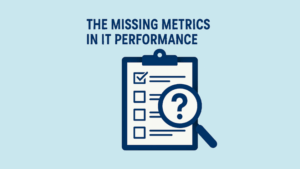Behind the Numbers: What Headcount Tells You About Your Function

Every IT leader tracks headcount. But not every leader is managing their workforce.
There’s a difference.
Most slides tell you how many people you have. But they rarely show how your function is actually built—or whether that structure is working.
If your headcount view is just a table of roles, contractors, and vacancies, that’s not the end, rather it’s a starting point.
Because before you can lead with insight, you need to see the full picture. Data is essential. And most IT leaders don’t have a complete view until they pull that first report.
But here’s the key: once you’ve got the data, you have to ask critical, insightful questions.
The headcount report gives you visibility and a place to start. But a workforce view that connects capabilities to performance, now that is powerful.
💡 It Starts with Capability Decisions
Most IT organizations already have people in place, often in long-held roles, by the time they start formal Function 360s. That’s why evaluating the function through the lens of capabilities is so powerful.
It starts with one question: What does this IT function need to be great at?
That becomes your anchor.
And from there, the hard decisions begin.
- What capabilities truly need to be built in-house for continuity, depth, or influence?
- What work might be better suited for external partners—because it’s transactional, temporary, or volatile?
- Where do we need more scale or speed? And where do we need stability?
In some cases, the answers will confirm where you’ve already invested well.
In others, they’ll reveal hard truths:
- Misaligned roles
- Overdependence on contractors
- Talent that no longer matches the function’s direction
These are not easy decisions. But if you want capabilities and structure to serve the strategy, you have to be willing to revisit what’s already in place.
✅ What Good Looks Like
A strong headcount and workforce view answers more than “who’s on the team.” It explains why the team is structured the way it is—and what that means for the function.
It should help you answer:
- Are we staffed to meet delivery goals?
- Where are we constrained—and what are we doing about it?
- Are we investing in the right areas, or just preserving legacy structures?
- Are we over-reliant on a single model?
It needs to be intentional, actionable, and grounded in how your function creates value.
That’s what builds credibility in the room—and capability in the function.
🎯 Why It Matters
Your workforce is more than an operating cost; it is your delivery model. And leaders don’t inherit that structure. They design it.
The headcount report is where the conversation starts but a workforce strategy is where it should conclude.
If you want to lead the function, not just track it, you have to move beyond roles and counts into capability, cost, and adaptability.


